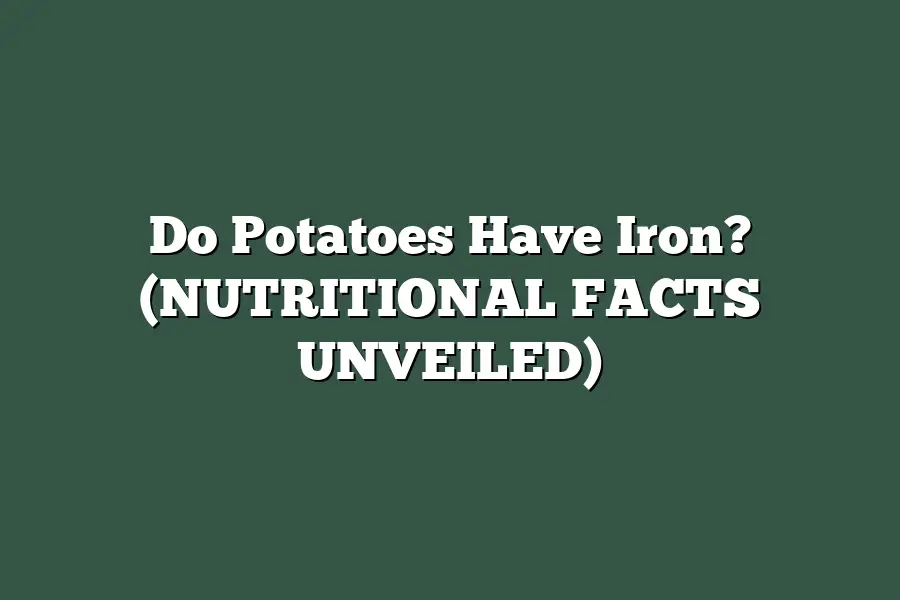Yes, potatoes contain iron, albeit in smaller amounts compared to other foods like meat and legumes. Consuming potatoes as part of a balanced diet can contribute to your daily iron intake but may not be the primary source. To boost iron absorption from potatoes, consider pairing them with vitamin C-rich foods like tomatoes or bell peppers.
Curious about the iron content in potatoes?
Let’s dig into the facts!
Learn why iron is essential, compare potatoes to other iron-rich foods, and get tips to boost your intake deliciously.
Time to uncover the potato’s nutritional secrets!
Table of Contents
Understanding Iron and its Importance in the Body
When it comes to our health, it’s important to understand the role that different nutrients play in our bodies.
Iron, in particular, is a crucial mineral that often sparks curiosity.
Let’s dive into understanding iron and its significance in the body.
What is Iron?
Iron is a mineral that our bodies need to function properly.
It plays a key role in producing red blood cells, which are responsible for carrying oxygen throughout the body.
Without enough iron, our cells and tissues won’t get the oxygen they need to function optimally.
Why is Iron Important?
Iron is essential for various bodily functions, including:
- Oxygen Transport: Iron is a component of hemoglobin, a protein in red blood cells that binds to oxygen and carries it from the lungs to the rest of the body.
- Energy Production: Iron is involved in the production of adenosine triphosphate (ATP), which is the primary source of energy for our cells.
- Immune Function: Iron helps support a healthy immune system by aiding in the production of white blood cells, which are vital for fighting off infections.
Iron Deficiency: A Common Concern
Iron deficiency is a prevalent global health issue, affecting approximately 1.62 billion people worldwide.
Some common signs of iron deficiency include fatigue, weakness, pale skin, and shortness of breath.
Sources of Iron
Iron can be found in two forms: heme iron, which is derived from animal sources, and non-heme iron, which is found in plant-based foods.
Foods rich in iron include:
- Heme Iron Sources:
- Beef
- Chicken
- Turkey
Fish
Non-Heme Iron Sources:
- Lentils
- Beans
- Spinach
- Quinoa
iron is a vital mineral that plays a crucial role in maintaining our overall health.
By understanding the significance of iron and incorporating iron-rich foods into our diets, we can support optimal bodily functions and ensure we stay healthy and energized.
Understanding iron and its importance in the body is the first step towards taking control of our health and well-being.
Exploring the Nutritional Value of Potatoes
When it comes to the nutritional value of potatoes, there’s more than meets the eye.
Let’s dive into the various aspects that make this humble vegetable a powerhouse of nutrients.
Rich in Essential Vitamins and Minerals
Potatoes are often overlooked for their nutritional content, but they actually contain a significant amount of key vitamins and minerals.
A medium-sized potato with skin provides:
– 20% of the recommended daily allowance of potassium
– 45% of the recommended daily value of vitamin C
– 10% of the recommended daily value of vitamin B6
Iron Content in Potatoes
While potatoes are not typically considered a high source of iron, they do contain a small amount of this essential mineral.
A medium-sized potato offers approximately 0.8 milligrams of iron, contributing to your daily intake.
Absorption of Iron from Potatoes
It’s important to note that the iron in plant-based sources like potatoes is non-heme iron, which is not as readily absorbed by the body as heme iron found in animal products.
To enhance the absorption of iron from potatoes, it’s recommended to consume them with foods rich in vitamin C, such as bell peppers or tomatoes.
Balanced Diet for Iron Intake
While potatoes can contribute to your overall iron intake, it’s crucial to maintain a balanced diet that includes a variety of iron-rich foods, especially for individuals at risk of iron deficiency.
while potatoes may not be a primary source of iron, they still offer a range of essential vitamins and minerals that make them a valuable addition to a well-rounded diet.
By understanding their nutritional value and incorporating them strategically into meals, you can benefit from the goodness they have to offer.
How Potatoes Compare to Other Iron-Rich Foods
When it comes to iron content, potatoes may not be the first food that comes to mind.
We often associate iron with foods like red meat or spinach.
However, potatoes do contain a notable amount of iron.
Let’s explore how potatoes stack up against other iron-rich foods.
Iron Content in Potatoes
First off, it’s essential to understand that the iron content in potatoes can vary based on factors like the variety of potato and how it’s prepared.
On average, a medium-sized potato with skin contains about 2.2 milligrams of iron.
While this may not seem like a lot compared to other foods, every bit of iron counts towards your daily intake.
Comparing Potatoes to Spinach
Spinach is often hailed as a superfood when it comes to iron content.
However, did you know that a medium-sized potato actually contains more iron than a cup of raw spinach?
Yes, you read that right!
While spinach contains approximately 0.8 milligrams of iron per cup, a potato offers around 2.2 milligrams.
Iron Absorption in Potatoes
Now, you might be wondering about the bioavailability of iron in potatoes compared to other foods.
Iron from plant-based sources, like potatoes, is known as non-heme iron.
This type of iron isn’t absorbed by the body as efficiently as heme iron from animal products.
To enhance the absorption of non-heme iron from potatoes, consider pairing them with vitamin C-rich foods like bell peppers or broccoli.
Potatoes vs Red Meat
Red meat is a well-known source of heme iron, which is easier for the body to absorb compared to non-heme iron.
A 3-ounce serving of beef can provide around 2.5 milligrams of iron, slightly more than a medium-sized potato.
However, it’s essential to balance your iron intake from both plant and animal sources for optimal health benefits.
while potatoes may not be the top contender for the highest iron content, they still offer a decent amount of this essential mineral.
By incorporating a variety of iron-rich foods into your diet, including potatoes, spinach, and red meat, you can ensure you’re meeting your daily iron requirements.
Remember, balance is key when it comes to maintaining a healthy diet rich in essential nutrients like iron.
Tips for Incorporating Iron-Rich Foods into Your Diet
Are you looking to boost your iron intake through your diet?
Incorporating iron-rich foods is a great way to ensure you’re meeting your body’s needs.
Let’s explore some practical tips to help you incorporate more iron into your meals.
1. Lean Towards Red Meat
Red meat is a fantastic source of heme iron, which is a highly absorbable form of iron for our bodies.
Beef, lamb, and pork are great options to consider if you’re looking to increase your iron intake.
For example, a 3-ounce serving of beef can provide around 2-3 milligrams of iron, contributing significantly to your daily requirements.
2. Opt for Poultry
Chicken and turkey are also excellent sources of heme iron.
Incorporating poultry into your meals can be a delicious way to add more iron to your diet.
A 3-ounce serving of chicken can provide approximately 1 milligram of iron, helping you reach your daily recommended intake.
3. Explore Plant-Based Options
If you follow a vegetarian or vegan diet, fear not!
There are plenty of plant-based sources of non-heme iron that can boost your iron levels.
Foods such as legumes, tofu, spinach, and quinoa are rich in iron and can be easily incorporated into various dishes.
Cooking with cast-iron cookware can also increase the iron content of your meals.
4. Pair Iron-Rich Foods with Vitamin C
Vitamin C enhances the absorption of non-heme iron from plant-based sources.
Consider combining iron-rich foods with sources of vitamin C, such as citrus fruits, bell peppers, or strawberries.
For example, squeezing lemon juice over a spinach salad can help improve the iron absorption from the spinach.
5. Avoid Consuming Iron Blockers
Certain substances can inhibit the absorption of iron in the body.
Avoid consuming iron blockers, such as coffee, tea, and calcium supplements, alongside iron-rich meals.
These substances can interfere with the body’s ability to absorb iron, reducing the overall effectiveness of your dietary iron intake.
By incorporating these tips into your meal planning, you can ensure that you’re meeting your body’s iron requirements effectively.
Whether you prefer red meat, poultry, or plant-based options, there are plenty of delicious ways to boost your iron intake and support your overall health and well-being.
Final Thoughts
While potatoes may not be the first food that comes to mind when thinking about iron-rich foods, they do contain a small amount of this essential mineral that can contribute to your daily intake.
Understanding the importance of iron in the body and the role it plays in keeping us healthy is key.
Remember, balance is key in a healthy diet, so incorporating a variety of iron-rich foods like spinach, red meat, and yes, potatoes, can help you meet your daily iron requirements.
Next time you enjoy a meal with potatoes, consider pairing them with other iron-rich foods to create a balanced and nutritious plate.
Your body will thank you for it!

